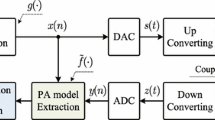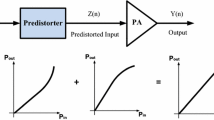Abstract
This paper presents a novel approach for estimating the Saleh model’s parameters using the gain and third-order intercept point (IP3) of a power amplifier. The IP3 is a widely used technical parameter for describing the nonlinearity of the power amplifier in wireless communications. The proposed approach minimizes an objective function of error between the third-order Taylor series and the Saleh Amplitude-to-Amplitude (AM/AM) model. This approach of the parameters estimation is also used for identifying the Digital Predistortion (DPD) to compensate for the memoryless AM/AM nonlinear distortion of power amplifiers in wireless communications. Finally, the Saleh model accuracy and DPD linearization are validated based on the WCDMA measurement signal.







Similar content being viewed by others
References
Adel S (1981) Frequency-independent and frequency-dependent nonlinear models of TWT amplifiers, in IEEE Transactions on Communincations, vol. 29, no. 11, pp. 1715-1720. https://doi.org/10.1109/TCOM.1981.1094911
Claude S (1948) A mathematical theory of communication. Bell Syst Tech J 27:379–423 623–656. https://doi.org/10.1002/j.1538-7305.1948.tb01338.x
Haider A, Fu L, Felice T (2017) Extended Saleh model for behavioral modeling of envelope tracking power amplifiers. In Proceedings of IEEE 18th Wireless and Microwave Techniques. (WAMICON), Cocoa Beach, FL, pp. 1–4. https://doi.org/10.1109/WAMICON.2017.7930244
Haider A, Felice T, Fu L (2018) Hystersis nonlinearity modeling and linearization approach for envelope tracking power amplifiers in wireless systems. Microlectron Jl 82:101–107. https://doi.org/10.1016/j.mejo.2018.10.006
John W (2014) Behavioral modeling and linearization of RF aower amplifiers. Artech house, Norwood
José P, Stephen M (2005) A comparative overview of microwave and wireless power-amplifier behavioral modeling approaches. IEEE Trans Microw Theory and Tech 53(4):1150–1163. https://doi.org/10.1109/TMTT.2005.845723
Magnus I, David W, Daniel R (2006) A comparative analysis of behavioral models for RF power amplifiers. IEEE Trans Microw Theory Tech 54(1):348–359. https://doi.org/10.1109/TMTT.2005.860500.
Mairtin O, Serban M, Yiming L (2009) New modified saleh models for memoryless nonlinear power amplifier behavioural modelling. IEEE Commun Lett 13(6):399–401. https://doi.org/10.1109/LCOMM.2009.090222
Mohammad S, Seyed S (2012) Performance of a predistorter based on Saleh model for OFDM systems in HPA nonlinearity. In Proceedings 14th Interenation Conference on Advanced Communication Techniques (ICACT), pp. 148–152
Steve C (2002) Advanced techniques in RF power amplifiers design. Artech house, Nonvood
Terry H, Ge J, Geng S, Wang G (2007) A nonlinearity predistortion technique for HPA with memory effects in OFDM systems. Nonlinear Anal. Real World Appl 8(1):249–256. https://doi.org/10.1016/j.nonrwa.2005.08.007
Tien N, James Y, Charles L, Hien T, Diana J (2003) Modeling of HPA and HPA linearization through a predistorter: global broadcasting service applications. IEEE Trans Broadcast 49(2):132–141. https://doi.org/10.1109/TBC.2003.813650
Xiao L, Fu L (2013) RF power amplifier’s nonlinear modelling with memory effect. Int J Electron Lett 1(1):44–49. https://doi.org/10.1080/21681724.2013.805382
Xiao L, Chunming L, Yang X, Fu L (2012) Obtaining polynomial coefficients from intercept points of RF power amplifiers. Electron Lett 48(19):1238–1240. https://doi.org/10.1049/el.2012.1734
Acknowledgments
The authors would like to acknowledge Dr. J. Veerman from the Math department, and Chenyang Li from the electrical and computer engineering department at Portland State University for their insight suggestions in the equations’ derivation.
Author information
Authors and Affiliations
Corresponding author
Additional information
Responsible Editor: S. Mir
Publisher’s Note
Springer Nature remains neutral with regard to jurisdictional claims in published maps and institutional affiliations.
Rights and permissions
About this article
Cite this article
Al-kanan, H., Yang, X. & Li, F. Saleh Model and Digital Predistortion for Power Amplifiers in Wireless Communications Using the Third-Order Intercept Point. J Electron Test 35, 359–365 (2019). https://doi.org/10.1007/s10836-019-05801-3
Received:
Accepted:
Published:
Issue Date:
DOI: https://doi.org/10.1007/s10836-019-05801-3




